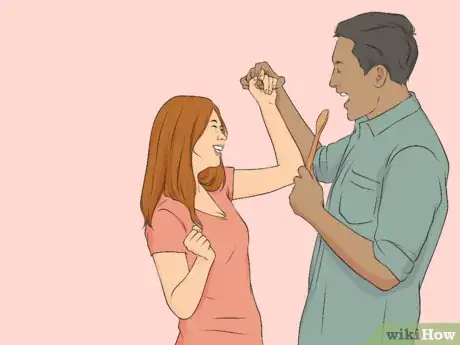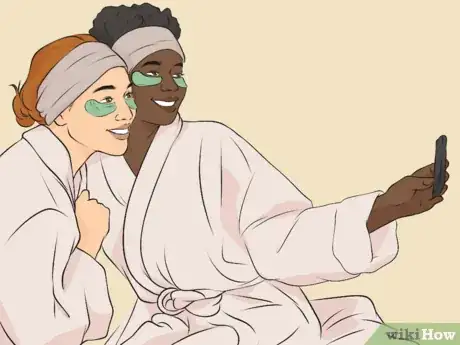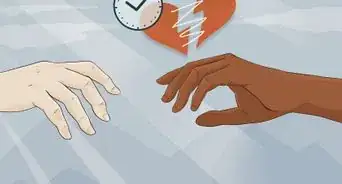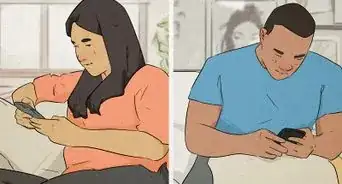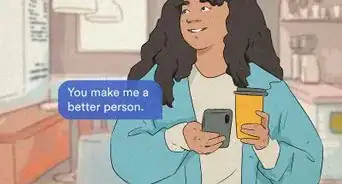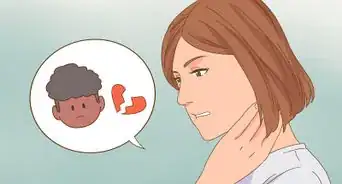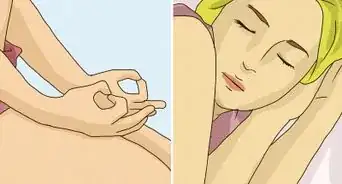This article was written by Sarah Schewitz, PsyD and by wikiHow staff writer, Finn Kobler. Sarah Schewitz, Psy.D. is a licensed clinical psychologist by the California Board of Psychology with over 10 years of experience. She received her Psy.D. from the Florida Institute of Technology in 2011. She is the founder of Couples Learn, an online psychology practice helping couples and individuals improve and change their patterns in love and relationships.
There are 13 references cited in this article, which can be found at the bottom of the page.
This article has been viewed 2,663 times.
A new relationship can feel like a traffic light. We’re looking for signs from our partner that tell us to slow down, stop, or keep going. That’s where green flags come in. Much more hopeful than their counterpart, red flags, we can use green flags to inform our emotional well-being and compatibility with our significant other. If you want to know more about green flags, keep reading! We’ll help you define them, give some examples, and offer context on how they relate to red flags.
This article is based on an interview with our licensed clinical psychologist and relationship coach, Sarah Schewitz, founder of Couples Learn. Check out the full interview here.
Things You Should Know
- A green flag is an action or trait that demonstrates healthy behavior. Green flags can be used as signs to determine if a relationship is functional or dysfunctional.
- One major green flag is your partner’s ability to communicate healthily. This is demonstrated in their ability to actively listen and their ability to express how they feel.
- If your relationship feels like it’s moving at a reasonable pace (not too fast, not too slow), that’s a big green flag.
- The biggest green flag is that you like being around your partner. As long as you feel respected, safe, and enjoy their company, other conflicts can be resolved.
Steps
Examples of Green Flags
-
1They actively listen. Active listening is key to building any partnership. It strengthens your bond and deepens your understanding of one another. If your partner makes an effort to understand and validate your feelings, this is a sign your emotional needs are a high priority for them.[3]
- Signs of active listening are paraphrasing, clarifying your statements (“So what I’m hearing is…” or “Let me make sure I understand…”), and reflecting on them (“It sounds like you’re feeling…”).
- Not listening doesn’t mean your partner doesn’t care. Common roadblocks to active listening are reassuring and fixing. These are all well-intentioned responses, but they don’t grasp the core of what you’re truly trying to say. If your partner does any of these, try telling them “I appreciate you trying to help, but I just need you to listen right now.”
-
2They respect your boundaries. Healthy partnerships are based on mutual respect. That includes honoring what you’re not comfortable with. Boundaries can be physical (your comfort being touched in certain places), emotional (being spoken to in a respectful way), mental (your values and belief systems), material (your comfort with certain items being used), or time-based (respecting your time by being prepared and present). Healthy partners are able to refrain from violating these boundaries even when they’re upset with you.[4]
- If you’re struggling with establishing boundaries, clear communication is always the best place to start. Sit your partner down and directly state what you are and aren’t okay with. Try to use I feel statements such as “I feel uncomfortable when…” to make it seem less accusatory.
- Create reasonable consequences when a boundary is crossed. For example, if someone constantly wastes your time by being late, tell them you’ll spend less time with them if it happens again.
- Sometimes boundaries get crossed accidentally! Maybe you ate the least bagel or said something you didn’t mean when you were angry. If you cross a boundary by mistake, apologize, clarify, and be more cautious in the future.
-
3They’re curious about your needs and interests. Effective communication revolves around talking just as much as it does listening. If your partner regularly asks you how you’re feeling and asks for clarification on things they don’t understand, that shows your well-being is important to them and they want to know you the best they can.[5]
- An easy way to show your curiosity is by asking clarifying questions after each statement. For example, if someone says “I want to buy a house some day,” ask “what kind of house do you want?” If someone says “I’m hungry,” ask “what would you like to eat?”
-
4They know how to express how they feel. It’s a great sign when your partner can articulate their emotions. Too often, we can get so wrapped up in our emotions that we take them out on other people. If your partner is able to voice when they feel a certain way and the intensity of that feeling, it makes it much easier to understand each other and this understanding helps solve the majority of relationship problems.
- Being emotionally articulate takes practice. One easy method to start sharpening this skill is to taking some time to register how you’re feeling in a situation. Are you breathing fast? That could be a sign of anger or fear. Chest feeling heavy? Maybe you’re sad.
- Remember not to judge your feelings once you register them. No emotion is good or bad. All feelings need to be felt.
-
5You can be vulnerable around each other. If you and your partner feel comfortable being “emotionally exposed” with one another: sharing emotions that may feel uncomfortable like shame, guilt, insecurity, or fear, it proves you make each other safe enough to let your walls down. This exposure allows you to build your relationship together and let in other, validating feelings like love, comfort, joy and acceptance.[6]
- It’s by no means a bad sign if vulnerability scares either of you. In fact, it’s totally normal! The best way to create a safe environment for vulnerability is with validation. Tell your partner reasons you respect them unconditionally and make it clear you will not judge them.
- Being vulnerable takes enormous courage. When your partner expresses vulnerability, acknowledge this and commend them for their bravery.
-
6The relationship moves at a reasonable pace. Steadiness is key to a healthy relationship timeline. If the relationship doesn’t feel like it’s moving too fast (saying “I love you” after 3 dates) or too slow (it’s been 2 years and you still haven’t met each other’s friends), that’s a green flag. Just remember: speed is different for everyone. “Too fast” for you may be “too slow” for someone else, so avoid comparing your relationship to others and communicate if you feel your relationship’s pacing is off.[7]
-
7They have other quality friends they spend time with. If your partner has other friendships with people you respect, this demonstrates not only that they know how to maintain healthy relationships with others, but also that your dynamic is less likely to be codependent. Every relationship has ups and downs, so it’s nice to know they have other people they can count on for companionship and emotional support.[8]
-
8They’re self-aware. Self-awareness shows your partner has a healthy sense of self. They recognize their limitations, their strengths (which are just as important) and how they come across. Two key signs of self-awareness are introspection (they regularly reflecting on their beliefs, who they are and what they stand for) and feedback (they seek the wisdom of others to improve themselves).[9]
- To cultivate more self-awareness in yourself, start asking “what” instead of “why.” Instead of focusing on why you feel a certain way or you received a certain criticism, focus on what the feeling is or the qualities of the criticism itself.
-
9You can count on them consistently. If your partner is reliable, it means you can trust them. A healthy relationship requires moments where you’ll need to depend on each other. If your partner regularly shows up for you, it shows they’re ready and willing to commit the necessary time and energy to your relationship as it grows.[10]
-
10You feel like friends AND partners. While romantic attraction is important, good relationships are founded on the basis of friendship. Make an effort to share and understand each other’s hopes and dreams, likes and dislikes, families, guilty pleasures, and all the things you know about any of your other close friends. A relationship that feels like a friendship is linked to long-term success.
-
11They’re good with compromise. A healthy partnership is rooted in equality; you should both have the same say in decision-making. If your partner is flexible and/or actively makes an effort to sacrifice some of their wants to find a solution that works for both of you, it’s a sign your relationship is capable of long-term growth.[11]
-
12They try to integrate you into their life. Just as it’s a great sign for you to have boundaries for each other’s independent hobbies and social circles, your partner’s willingness to invite you into key aspects of their life shows that they want to share a future with you. If your partner introduces you to their close friends, their family, or even shows you an activity or movie they love, it’s a sign your opinion matters and they want you around.[12]
-
13You have shared interests and values. The more you have in common, the easier it is to build a relationship. Having a mutual core system of beliefs is important for building a life together. It’s also easier to connect when you have a lot of things to bond over. While it’s by no means a red flag if you and your partner are different (couples of different religions, nationalities, and political preferences make it work all the time), the ability to accept each other’s differences and find common ground is key.
-
14You feel good when you’re around them. The simplest and most common green flag is often the most overlooked. If you like being around your partner and you like yourself when you’re in their company, odds are you have a strong relationship. Issues like boundaries, trust, and pacing can be improved with time and communication as long as you feel respected and enjoy their company.[13]
References
- ↑ https://www.thehotline.org/resources/green-flags-in-a-relationship/
- ↑ https://sawtoothmountainclinic.org/wp-content/uploads/2021/02/TOM-Feb-2021-Relationship-Green-Lights-c.pdf
- ↑ https://www.bumc.bu.edu/facdev-medicine/files/2016/10/Active-Listening-Handout.pdf
- ↑ https://www.helpguide.org/articles/relationships-communication/setting-healthy-boundaries-in-relationships.htm
- ↑ https://wellbeing.jhu.edu/blog/2021/04/08/green-flags/
- ↑ https://www.takingcharge.csh.umn.edu/daring-be-vulnerable-brene-brown
- ↑ https://www.joinonelove.org/learn/is-your-relationship-moving-at-a-healthy-pace-according-to-experts/
- ↑ https://wellbeing.jhu.edu/blog/2021/04/08/green-flags/
- ↑ https://hbr.org/2018/01/what-self-awareness-really-is-and-how-to-cultivate-it
- ↑ https://www.therapistaid.com/worksheets/relationship-green-flags
- ↑ https://www.thehotline.org/resources/green-flags-in-a-relationship/
- ↑ https://www.therapistaid.com/worksheets/relationship-green-flags
- ↑ https://www.joinonelove.org/learn/6-relationship-green-flags-to-look-for-in-a-new-relationship/
- ↑ https://sawtoothmountainclinic.org/wp-content/uploads/2021/02/TOM-Feb-2021-Relationship-Green-Lights-c.pdf
- ↑ https://www.joinonelove.org/signs-unhealthy-relationship/
- ↑ https://www.apa.org/monitor/2021/11/feature-cultivating-empathy
- ↑ https://health.clevelandclinic.org/domestic-abuse-how-to-spot-relationship-red-flags/





